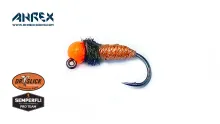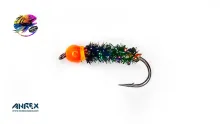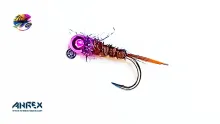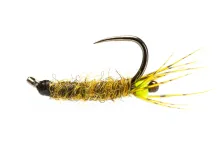This nymph pattern teaches you how to make a sparkling hackle from organza ribbon – in two different ways even!
If fly tyers think of organza, and they should, it’s a very versatile material, they will be most likely thinking of just one aspect. Its most common use is to wind the synthetic herl produced by cutting the edge off the ribbon and stripping out the long fibres. Some tiers, including me, use these fibres for tails, add them to poly-yarn wings for veins and sparkle, or use them to rib dubbed bodies.
The thin flexible fibres sparkle as light reflects from the crimps imparted by the weaving process. With the right technique they can be used to add a very attractive soft synthetic hackle to a fly by inserting them into a split thread. The secret to success is to use the right thread.
The fine organza fibres are slippery and need a thin thread to grip them. Using a thick multi-strand thread that is easy to flatten and split, such as UTC-70, tends to make the fibres slide around and tangle as you spin the thread to tighten it. Sheer 14/0 works much better, the thread fibres are closer in thickness to the organza fibres and hold them in place as you spin the thread.
The Organzackle is tied using a single piece of narrow organza ribbon used in two ways, leaving little waste. I like that when tying a pattern. The stripped ribbon is twisted around a length of yarn and wound to produce a spiky segmented body. The fibres stripped from the same piece of ribbon are chopped and inserted into a split thread and wound to make the synthetic soft hackle.
I mentioned earlier that tying the Organzackle uses almost all the organza ribbon with little waste. The only bit you don’t use is one woven selvedge. You can, by using a second piece of contrasting ribbon to tie a variant pattern, use all the ribbon.
The fly below, the SHOJO (Soft Hackle Organza Just Organza), uses the brown selvedge leftover from tying a Organzackle with a piece of selvedge from a tan ribbon to wind a segmented body. The soft hackle is tied using fibres from both colours of ribbon. It makes a nice March Brown approximation which definitely looks like fish food.
These two patterns have done well for me at the beginning of the trout season in shallow riffly water with the Organzackle on the point and the SHOJO on a dropper. They are both tough little flies and hold up well to the rigours of fishing and fish. You won’t be retiring these after a day on the water because the body is tattered, or CDC or partridge hackle fibres have been shredded by trout teeth.
Nick Thomas
- Log in to post comments











